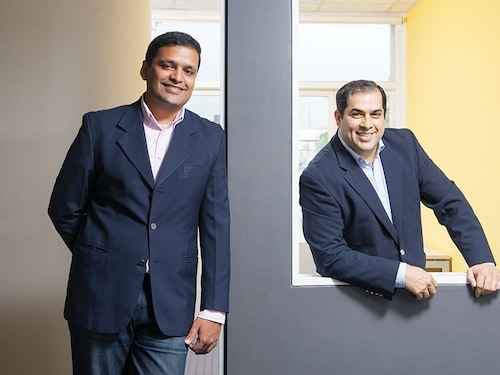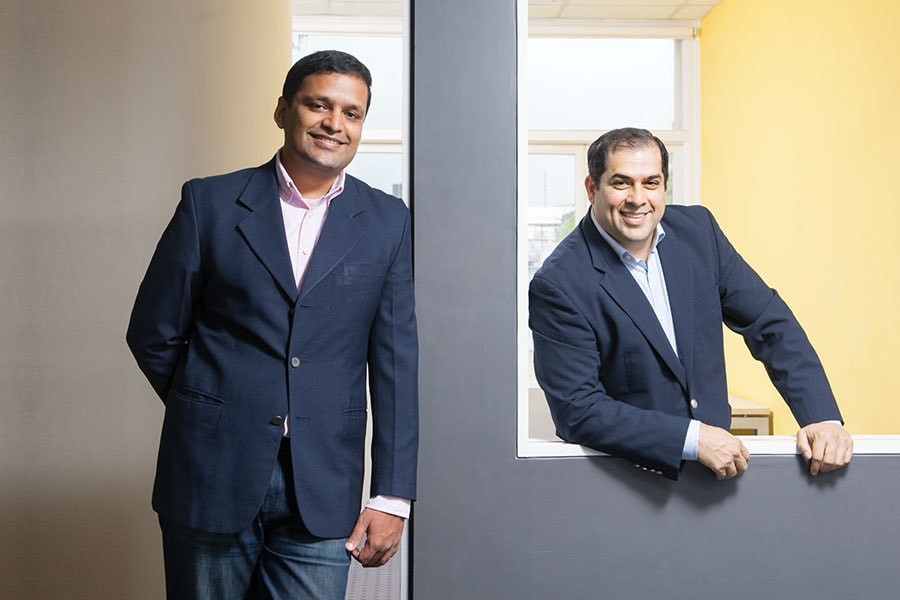Firms shouldn't raise debt without enough cash flow: Ajay Hattangdi
Co-founders of Alteria Capital, Ajay Hattangdi and Vinod Murali, on the venture debt model in India and why they focus on asset-light sectors


 Vinod Murali (left) and Ajay Hattangdi started Alteria Capital in 2017
Vinod Murali (left) and Ajay Hattangdi started Alteria Capital in 2017
Image: Mexy Xavier
Ajay Hattangdi, 48, and Vinod Murali, 37, former executives at InnoVen Capital, an arm of Temasek Holdings, launched venture debt firm Alteria Capital in 2017. A ₹800-crore corpus with a green shoe option (that allows a fund to overshoot its original target corpus by a certain amount) of ₹200 crore makes it the largest homegrown venture debt fund.
Venture debt firms lend at 14-16 percent to startups. They accept collaterals like warrants in the company and give startups an option to raise capital without diluting equity.
Since raising ₹356 crore in March from domestic investors, Alteria Capital has backed Fingerlix, Toppr and Universal Sportsbiz. In an interview to Forbes India, the duo talks about the evolution of venture debt in India. Edited excerpts:
Q. How is venture lending in India different from established markets?
Hattangdi: Venture debt in the US, for instance, is available to companies that have technology and an element of intellectual property (IP) in them.
In India, there is a wide range of industries and the canvas of opportunities is much wider, but it isn’t as deep in the technology vertical. If you take the traditional venture debt model, you won’t have the ability to deploy as much in India because the US outlook doesn’t work here.
In India, we look for drivers that provide companies with a competitive advantage and replace IP as a driver of enterprise value.
Murali: Venture debt rides on the predictability of venture equity. In the US, it trailed equity by two to three decades. In India, venture equity and debt started around the same time. Hence, there was no body of work as a precedent to figure out how venture equity plays out. There has been a lot of evolution in fund size, shape and focus in the last 15 years, largely because everybody is trying to figure out the right model for India. It is neither China nor the US, but somewhere in between. Here, we are still looking for the first wave of success as an ecosystem. There have been only a few exits, which haven’t defined the ecosystem yet. Similarly, from a debt perspective, it is also a lot about learning the ropes as many of the traditional approaches used in the US are not relevant here.
Q. What got domestic investors interested in your fund?
Murali: It was a straightforward proposition. Over the last 2-3 years, debt yields have dropped quite sharply. There has been lower returns from fixed-income products and a large part of Indian wealth is still in fixed income. The equity market has been through ups and downs. There is a growing trend among large families to diversify into alternative asset classes, which lie in between debt and equity. There was a fair bit of an interest to deploy [money] into an asset class which can give safety, as well as a small bump up in returns. We got Sebi’s [Securities and Exchange Board of India] nod [to raise funds] in November last year and made the first close in 100 days.
Q. What kind of returns are you talking about?
Murali: Debt products today give returns of about 6-8 percent. Bonds, post tax, may give about 8 percent. Our product gives 2-4 percent more than that because there is also an element of equity, the returns of which depend on how India as a venture market pans out in the next 5-7 years. The expectation is, it will be better than fixed-income products. The downsides are protected and there is a predictable return coming from the debt part, even as there is an [equity] upside from companies doing well.
Q. How has startups’ appetite about venture debt changed in the last 10 years?
Murali: The first cycle was the most brutal. A lot of time was spent in evangelisation. The fundamental question from the founders was: ‘What happens if I am not able to pay? I don’t want somebody at my door one morning.’ Most of the founders have never tasted debt in their personal life. Secondly, they wanted to know how debt will be useful to the company. With time, these questions have been answered. The providers of leverage need to be perceived as reliable partners in good and bad times. We want to be part of the solution, not the problem. Today, there is a high level of awareness about debt and great reciprocation from the founders.
Q. Which are the sectors that interest Alteria?
Hattangdi: There is no successful model for venture debt for pre-series A companies because the mortality rate is extremely high there. Adding debt makes the situation worse. Firms should not raise debt until there is enough cash flow or there is some equity buffer.
We are fairly agnostic about new economy companies. We like food, apparel, ed-tech, both online and offline consumer companies, as well as health care. We look at sectors where venture capital (VC) interest is growing. The companies that we fund should be in the zone of love for the VCs. Where there is a lot of frenzy, we wait to see the companies and patterns emerging from that.
We typically don’t do real estate or infrastructure, or sectors which inherently involve a lot of asset creation. We focus on asset-light sectors.
Q. A number of venture debt funds have been floated of late. How do you differentiate?
Hattangdi: It takes more than capital to make a company successful. We are trying to build a platform. What we want to do ultimately is to create a range of services and products through collaborations and partnerships, where we will bring the ecosystem together—investors, mentors, potential clients and acquirers—for the companies that we serve.
Murali: Capital will be commoditised quickly. There will be new instruments which will accelerate this commoditisation. Access to capital will also be democratised. In that case, it is important for providers of capital to differentiate themselves. We don’t want to be pitted against the other providers of venture debt with the same benchmarking.
First Published: Jun 25, 2018, 11:30
Subscribe Now